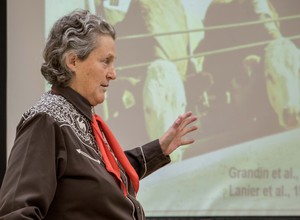Grandin advocates for animal well-being; better understanding of autism

CHADRON – Hundreds of Nebraska Panhandle students gathered at Chadron State College Jan. 28, along with CSC faculty members, ranchers and residents to hear Dr. Temple Grandin, a national leader who advocates for humane livestock handling and better understanding of people on the autism spectrum.
Grandin, a Colorado State University professor as well as prolific author, shared her ability about how she processes visual information, allowing her insight into stimuli that affect livestock to a capacity crowd Thursday at Memorial Hall.
The evening program capped off a busy day for Grandin.
While speaking to Chadron State and Chadron High School students in the Burkhiser Complex Thursday morning, Grandin, 68, explained combinations of animal behavior and management techniques to reduce stress when working cattle in feed yards, auctions and packing plants.
She studies outcomes, measured in percentages, to indicate the level of humane treatment of cattle in these venues: falls, vocalization in the stun chute, successful first stuns, electric prod usage and other metrics.
“Measuring is important. It prevents a bad situation from becoming normal,” she said.
She outline a few simple changes ranchers can make in their crowding pens and chutes to reduce anxiety in the animals they are working.
“Light your buildings or trailers. Cattle will not go into a black hole. They don’t like glare, so don’t work them in the middle of the day, if you can avoid it. Provide non-slip floors where you can,” she said.
Although she is known throughout North America for her handling equipment designs that facilitate calm movement of cattle, she noted not all young producers can afford permanent structure or solid panels that block vehicles, glare and dogs from the cattle’s view.
Grandin sketched the “Bud Box,” Bud Williams’ adaptation for smaller operations that uses portable panels and the animals’ natural tendency to keep a distance from humans called the flight zone to move cattle from holding pens into a chute in wide curves.
“Avoid sharp bends. Cattle will not move ahead if they can’t see what’s up there. Also be aware there are a lot of things out there being called “Bud Boxes” that are not the real thing,” Grandin said.
Grandin uses “U” shaped curves in her design because cattle possess an innate instinct to return where they came from.
“Even during a barn fire, they will try to go back into the burning building. This is a strong urge, so use it to your advantage,” she said.
Grandin also encouraged livestock operators to provide positive experiences for cattle.
“Their first experience in your corral needs to be a positive one or they won’t want to come back. Bring them in one day and just feed them so you can get them back when you need to,” she said. “If cattle are abused, they will hold a fear memory for the rest of their lives. They are sensory learners. When you twist their tail and they move, give them some relief for their cooperation.”
The genetic make-up of cattle is also a consideration. Grandin said some tend to be high-strung and prone to excitability than others. This fact is proven based on cortisol levels in the blood, a stress hormone, tested in resting breeds versus those that are being handled in crowding pens.
“We’ve been selecting genetically for calmer temperament for 20 years. When I started in this business, cattle were wild,” she said.
Not only were the cattle wild, but some of the men in feed yards and packing plants where she first worked ranged from menacing to violent, harassing her sexually and throwing bull testicles on her pickup windshield as accurately depicted in the HBO movie, according to Grandin.
However, Grandin persevered. She credits her mother, Eustacia Cutler, with helping her develop social skills beginning with responsibilities as being a party hostess, gently pushing her out of her comfort zone.
“Autistic children can benefit from social responsibilities such as helping set up chairs for a church social or getting a job outside the home such as a paper route,” she said.
Cutler, who often appears via Skype during Grandin’s speaking engagements, used, “different, not less,” to describe her misunderstood child when dealing with leery and obtuse school administrators.
In the evening program in Memorial Hall, Grandin emphasized the benefits of different minds working together.
She shared digital images of her brain compared to a control subject, showing her visual cortex is about five times larger than the average person’s. She described her response to verbal cues return as images instead of words.
Grandin emphasized not every autistic child will be a visual thinker and not every autistic child will be verbal. She urged parents in the audience to seek speech therapy immediately when they notice their child is not developing normal speech patterns.
She also urged those in the audience on the autism spectrum to build a portfolio of their work and have it ready to show potential customers, investors or partners.
“Welding, computer coding and art are great skills you can be successful with. A general education in things like algebra and geography is not always necessary. The most important thing, is to get up and get it done. If there is an opportunity, take it,” Grandin said.
Category: Campus Events, Campus News
